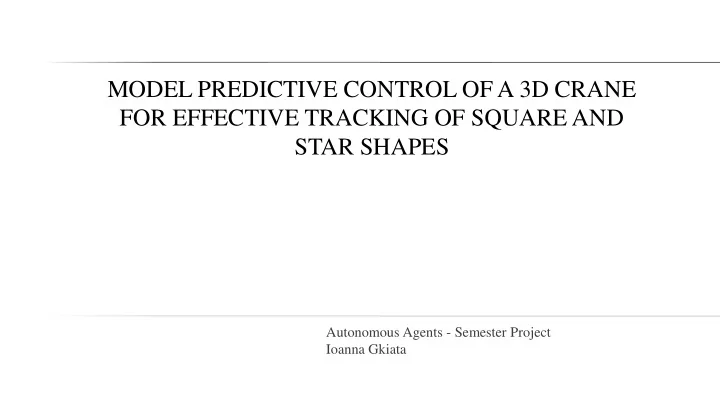

MODEL PREDICTIVE CONTROL OF A 3D CRANE FOR EFFECTIVE TRACKING OF SQUARE AND STAR SHAPES Autonomous Agents - Semester Project Ioanna Gkiata
MPC FOR TRAJECTORY TRACKING (1) Model Predictive Control (MPC) for trajectory tracking, involving both soft constraints (constraints that can be violated) and hard ones (constraints that cannot be violated), involves the solution of the following optimal control problem:
MPC FOR TRAJECTORY TRACKING (2) The abovementioned optimal control problem must be reformulated as a quadratic programming (QP) optimization problem in order to be solved efficiently by MATLAB. In particular we will use the function mpcqpsolver () from MATLAB’s Model Predictive Toolbox, which requires a specific form of a constrained quadratic programming (QP) problem to be considered:
THE 3D CRANE SIMULINK BLOCK A Simulink Multibody Mechanical Block for a 3D Gantry Crane from INTECO Corporation. This Simulink Block represents a highly nonlinear MIMO laboratory model imitating an industrial gantry crane. It is suitable for research and teaching in the field of control engineering. The real and simulated systems can move independently in three perpendicular directions. The current load deviations from the equilibrium down position are permanently processed by a control algorithm due to the 2-D angle measuring unit. We derive the nonlinear and linear models and compare their performance under the MPC setting.
A SIMPLIFIED MODEL We simplify the gantry crane system as just a payload (pendulum) on a movable support: where r is the length of the pendulum, m is the mass of the bob, M is the mass of the movable support, θ is the angle of the pendulum with respect to the x-axis and ψ is the related angle of the pendulum with respect to the y-axis (not shown for simplicity).
INITIAL EXPERIMENTS: THE EFFECT OF OPTIMIZATION PARAMETERS ON TRACKING PERFORMANCE We will test our implementation on the square shape tracking case using some "initial" parameter values. This is required in order to get an initial feeling on the values of the optimization parameters. Observe some important remarks on their related effect on control design. Similar observations can be shown also in the star shape tracking case.
THE MOST SENSITIVE PARAMETERS OF THE IMPLEMENTED CONTROL DESIGNS Sampling Time Ts : The increase or decrease of the sampling time gives an obvious difference only at the constrained linear MPC. In addition, the optimization time gets sufficiently lower or larger, respectively Prediction horizon in seconds Tf: The increase or decrease of Tf gives a difference only at the constrained case (on linear and nonlinear MPC) Weights on X (Q(1,1)) and Y(Q(3,3)) directions Penalizing the angles θ (Q(5,5)), ψ (Q(7,7)) Penalty on the input R The change of parameter values had an IMMEDIATE effect on the constrained linear MPC.
INITIAL EXPERIMENTS: TRACKING PERFORMANCE
SQUARE SHAPE TRACKING PERFORMANCE: UNCONSTRAINED PI AND RHC (GAIN K)
SQUARE SHAPE TRACKING PERFORMANCE: CONSTRAINED LINEAR MPC
SQUARE SHAPE TRACKING PERFORMANCE: CONSTRAINED NONLINEAR MPC
STAR SHAPE TRACKING PERFORMANCE: UNCONSTRAINED PI, RHC
STAR SHAPE TRACKING PERFORMANCE: CONSTRAINED LINEAR MPC
STAR SHAPE TRACKING PERFORMANCE: CONSTRAINED NONLINEAR MPC
CONCLUSIONS During the whole simulation procedure, it is obvious that the case of the constrained linear MPC seemed to be the most satisfactory, since it could easily track shapes in the XY-plane with great accuracy, as well as it could satisfy challenging constraints (e.g. very small pendulum oscillations).
Recommend
More recommend